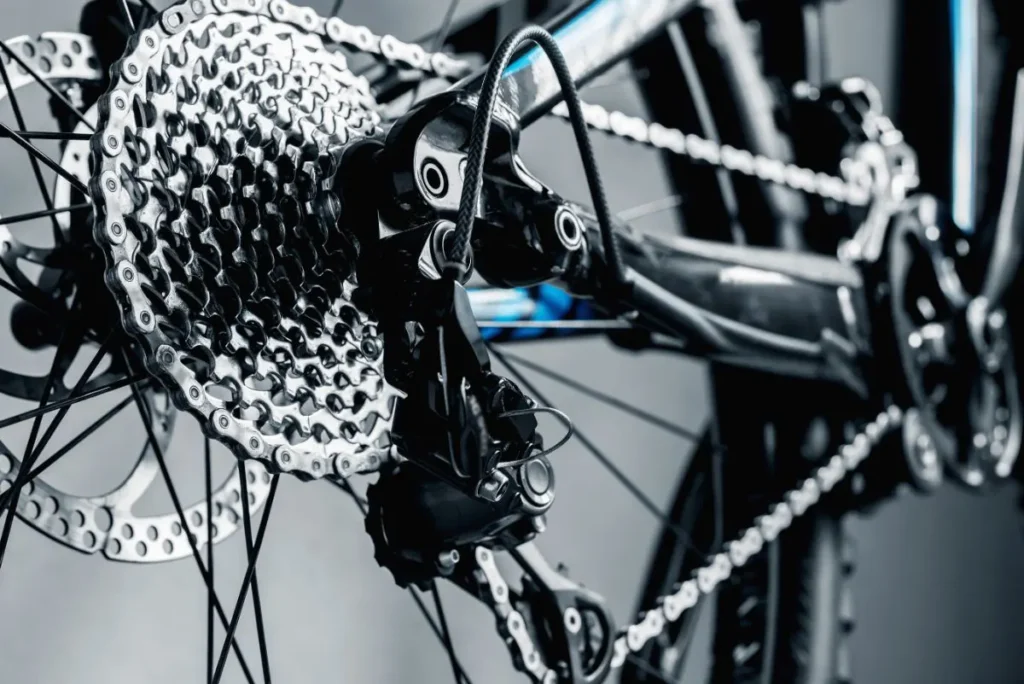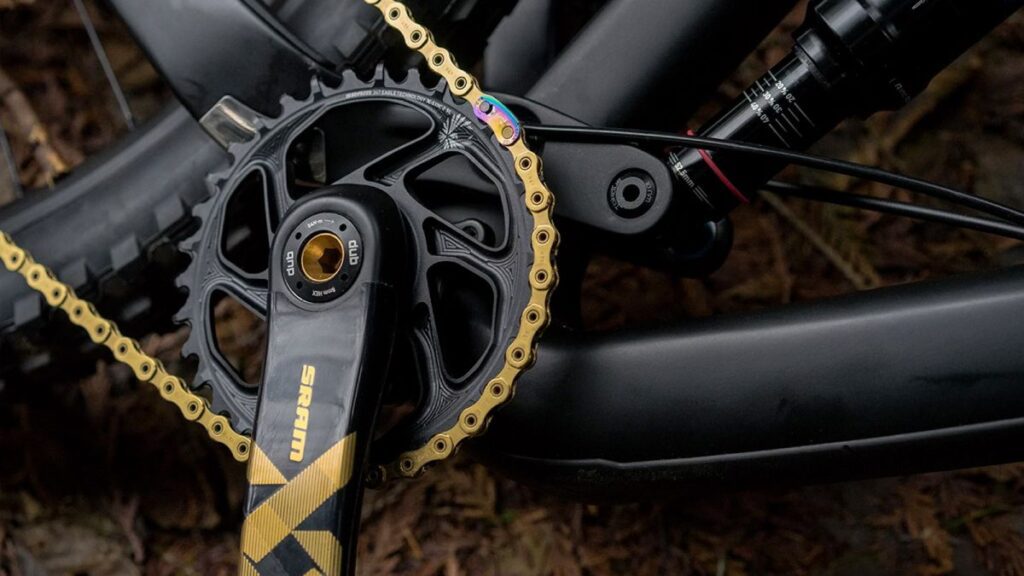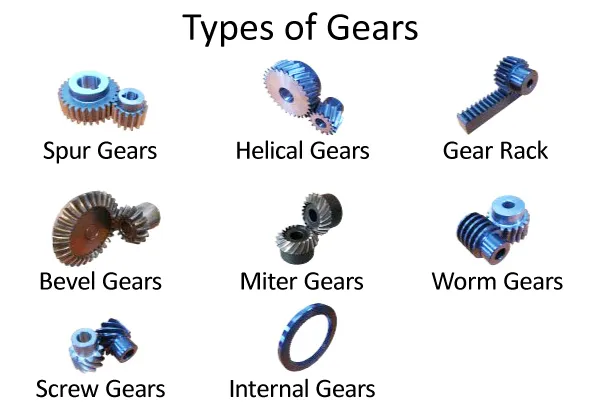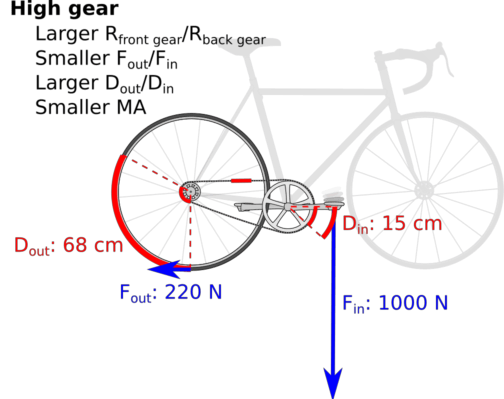


“Unlocking the potential of a mountain bike, the multitude of gears offers versatility and adaptability. From steep climbs to exhilarating descents, the varying gear options empower riders to conquer any terrain with precision and efficiency.”
Mountain bikes typically have a wide range of gears to handle various terrains and riding conditions. The number of gears on a mountain bike can vary depending on the specific model and intended use.
Read More : ” Can Bike Riding Cause Prostate Problems? “
However, most modern mountain bikes are equipped with a drivetrain that includes multiple gears.
Traditionally, mountain bikes featured a triple chainring setup with three front gears and a cassette with multiple rear gears. This provided a wide range of gear ratios to accommodate steep climbs and fast descents.
In recent years, many mountain bikes have transitioned to a 1x (pronounced “one-by”) drivetrain, which uses a single front chainring paired with a wide-range cassette on the rear wheel.
This simplifies the gear system and reduces weight while still offering a broad range of gears.
The number of gears on a mountain bike can range from 7 to 12 or even more, depending on the drivetrain configuration and manufacturer. The number of gears determines the total number of available gear ratios, allowing riders to find the perfect gear for any situation.
whether it’s climbing a steep hill, cruising on flat terrain, or flying downhill at high speeds.
Having multiple gears on a mountain bike provides versatility and allows riders to optimize their pedaling efficiency and power output. It enables smooth transitions between gears, ensuring a comfortable and efficient ride across various terrains.
Whether you’re a beginner or an experienced rider, understanding the gears on your mountain bike and learning how to use them effectively will enhance your overall cycling experience.
Read More : ” How To Ride Uphill On A Mountain Bike? “
Traditional Triple Chainring Setup: The Classic Three-Gear Front Configuration



The traditional triple chainring setup, also known as the classic three-gear front configuration, is a common gearing system found on mountain bikes. It consists of three front chainrings, typically labeled as the smallest (inner), middle, and largest (outer) rings.
Read More : ” How Does Mountain Bike Suspension Work? “
Each chainring offers a different gear ratio, allowing riders to adjust their pedaling effort based on the terrain and desired speed.
The purpose of the triple chainring setup is to provide a wide range of gear options to tackle various riding conditions. The smallest chainring offers a lower gear ratio, providing easier pedaling for climbing steep hills or navigating challenging terrains.
The middle chainring provides a moderate gear ratio for flat or rolling terrains, while the largest chainring offers a higher gear ratio for faster speeds on flat roads or descents.
The advantage of the triple chainring setup is its versatility and ability to cater to different riding scenarios. It allows riders to optimize their pedaling efficiency and maintain a comfortable cadence throughout the ride.
However, it also adds weight and complexity to the drivetrain system.
In recent years, the popularity of the triple chainring setup has declined, with more riders opting for simplified drivetrain configurations, such as 1x (one-by) systems.
Nevertheless, the traditional triple chainring setup remains a reliable choice for riders who prioritize a wide gear range and precise gear selection.
In summary, the traditional triple chainring setup is a classic and versatile gearing system on mountain bikes, offering a range of gear ratios to accommodate various terrains and riding preferences.
Read More : ” How To Get Better At Downhill Mountain Biking? “
Transition to 1x Drivetrain: Embracing the Single Front Chainring System



The transition to a 1x drivetrain, which embraces the single front chainring system, has been a significant development in mountain biking. In this setup, the traditional triple chainring is replaced with a single front chainring and a wide-range cassette at the rear.
This configuration offers several advantages that have made it increasingly popular among riders.
One of the main benefits of a 1x drivetrain is simplicity. With only one front chainring, the shifting process becomes easier and more intuitive, eliminating the need to navigate between multiple chainrings.
This simplification also reduces the risk of dropped chains and provides a cleaner aesthetic.
The 1x drivetrain offers a wide gear range, comparable to that of a traditional triple chainring setup, thanks to the development of wide-range cassettes. These cassettes feature a larger range of gears at the rear, allowing riders to tackle both steep climbs and high-speed descents.
Another advantage of the 1x drivetrain is weight reduction. By eliminating the front derailleur, multiple chainrings, and associated components, the overall weight of the bike is reduced, leading to improved acceleration and maneuverability.
The transition to a 1x drivetrain is also driven by advancements in technology. The availability of clutch-based rear derailleurs and narrow-wide chainrings has greatly enhanced chain retention, reducing the chances of chain drops even on rough terrain.
It is important to note that the transition to a 1x drivetrain may require some adjustment in riding technique, as there may be larger gear jumps between cogs.
However, many riders find the benefits outweigh this minor adjustment.
In conclusion, the transition to a 1x drivetrain has revolutionized mountain biking, offering simplicity, a wide gear range, weight reduction, and improved chain retention.
This evolution in drivetrain technology continues to shape the future of mountain biking and enhance the riding experience for enthusiasts worldwide.
Read More : ” How To Become A Better Mountain Biker? “
Range of Gears: Understanding the Available Gear Options



The range of gears available on a mountain bike plays a crucial role in determining its versatility and performance across various terrains. Understanding the available gear options allows riders to optimize their riding experience and tackle different riding conditions effectively.
Mountain bikes typically offer a wide range of gears to accommodate a variety of riding scenarios. The gear range refers to the combination of chainrings at the front and cogs at the rear, which determines the number of gear ratios available to the rider.
A traditional mountain bike drivetrain may feature a triple chainring setup at the front, which includes three different-sized chainrings. This configuration offers a wide range of gear ratios, enabling riders to conquer both steep climbs and fast descents.
The smaller chainring is ideal for steep inclines, while the larger chainring provides higher speeds on flat or downhill sections.
In recent years, a popular trend has emerged with the adoption of 1x drivetrains, which feature a single front chainring and a wide-range cassette at the rear. This setup simplifies the gear shifting process and reduces weight,while still offering a broad range of gears.
The wide-range cassette includes a greater number of cogs, providing a wide gear range suitable for a variety of terrains.
Additionally, advancements in technology have led to the development of drivetrains with even larger gear ranges. Some mountain bikes now feature drivetrains with extended cassettes, offering an expansive range of gears for tackling the steepest climbs and the fastest descents.
The choice of gear range depends on various factors, including the rider’s fitness level, terrain preferences, and riding style. Riders who frequently encounter steep climbs may prefer a wider gear range with smaller chainrings, while those who prioritize high-speed descents may opt for a larger front chainring and a cassette with wider gear spacing.
In conclusion, understanding the available gear options on a mountain bike is crucial for selecting the appropriate drivetrain that suits individual riding needs.
Whether it’s a traditional triple chainring setup or a modern 1x drivetrain, the range of gears plays a vital role in optimizing performance and versatility on the trails.
Read More : ” Why Is Mountain Biking So Popular? “
Gear Ratio and Functionality: The Relationship Between Gear Ratios and Pedaling Efficiency



Gear Ratio and Functionality: The Relationship Between Gear Ratios and Pedaling Efficiency
Understanding the gear ratio and its impact on pedaling efficiency is essential for optimizing your mountain biking experience. By finding the right gear ratios, you can improve your pedaling efficiency and overall performance on various terrains.
The gear ratio is determined by the number of teeth on the front chainring compared to the number of teeth on the rear cassette cog. It affects the mechanical advantage and determines how easy or hard it is to pedal.
By choosing the appropriate gear ratio, you can adapt to different riding conditions. Lower gear ratios provide a lower mechanical advantage, making it easier to pedal uphill or conquer challenging terrains.
On the other hand, higher gear ratios offer a higher mechanical advantage, enabling faster speeds on flat or downhill sections.
Finding the optimal gear ratio is crucial for maintaining a smooth and efficient pedaling cadence. It depends on factors such as your fitness level, the steepness of the terrain, and your desired pedaling cadence.
Experimenting with different gear ratios during your rides will help you determine the most comfortable and efficient setup for your riding style.
Ultimately, understanding the relationship between gear ratios and pedaling efficiency allows you to make informed decisions when it comes to gear selection.
By optimizing your gear ratios, you can maximize power transfer, minimize fatigue, and enhance your overall performance on the trails.
So, take the time to explore different gear ratios, experiment with your setup, and find the perfect balance that suits your riding style and enhances your pedaling efficiency.
Read More : ” Why Are Downhill Bikes So Expensive? “
Choosing the Right Gearing System: Factors to Consider for Selecting the Appropriate Number of Gears



Selecting the right gearing system for your mountain bike is crucial to optimize your riding experience. The number of gears on a mountain bike can vary, and understanding the factors to consider when choosing the appropriate number of gears is essential.
One of the primary considerations is the type of terrain you’ll be riding on. If you frequently encounter steep hills and challenging ascents, a larger number of gears can provide a wider range of options to tackle varying gradients.
On the other hand, if you predominantly ride on flatter terrain or focus on downhill descents, a smaller number of gears may be sufficient.
Your riding style and fitness level also play a role in determining the ideal number of gears. Riders who prefer a higher cadence and faster pedaling may benefit from a larger number of gears to maintain an optimal rhythm.
Conversely, riders who prefer a more powerful, slower cadence may find that a smaller number of gears is suitable for their needs.
Consider your experience level as well. Beginners may benefit from a wider range of gears to accommodate their developing strength and technique, while more experienced riders may prefer a more specialized gear setup tailored to their riding style and preferences.
Ultimately, selecting the appropriate number of gears involves finding the right balance between versatility and simplicity. It’s important to test and experiment with different gear setups to determine what works best for you and your riding needs.
So, take into account the terrain, your riding style, fitness level, and experience when choosing the right gearing system for your mountain bike.
By considering these factors, you can ensure that you have the optimal number of gears to enhance your riding performance and enjoyment on the trails.
Read More : ” Can You Ride A Mountain Bike On The Beach? “
Adjusting Gears for Optimal Performance: Tips on Fine-Tuning and Maintaining the Drivetrain



Properly adjusting and maintaining the gears of your mountain bike is crucial to ensure smooth and efficient shifting, as well as maximize your overall riding performance.
Here are some essential tips for fine-tuning and maintaining your bike’s drivetrain.
- Indexing: Properly indexing the gears involves aligning the derailleur to ensure precise and reliable shifting. Use the barrel adjuster to fine-tune the cable tension and achieve crisp gear changes.
- Limit Screws: Adjust the high and low limit screws on the derailleur to prevent overshifts or chain rub. This ensures the chain stays within the designated gear range without any unnecessary noise or potential damage.
- Chain and Cassette Inspection: Regularly inspect the chain and cassette for signs of wear. A stretched chain or worn cassette can cause poor shifting performance. Replace them as needed to maintain optimal gear functionality.
- Cable and Housing Maintenance: Clean and lubricate the gear cables and housing to reduce friction and ensure smooth cable movement. Replace any worn or damaged cables and housing for improved shifting performance.
- Fine-Tuning: Fine-tune the gear adjustments by making small incremental changes to achieve the desired shifting smoothness. Pay attention to the indexing and ensure each gear engages properly without skipping or chain slippage.
- Regular Cleaning: Keep your drivetrain clean by regularly removing dirt, debris, and excess lubrication. A clean drivetrain not only improves shifting but also prolongs the lifespan of your gears and drivetrain components.
By following these tips and regularly maintaining your drivetrain, you can ensure optimal gear performance and a smooth riding experience.
Remember to consult your bike’s user manual or seek assistance from a professional if you’re unsure about any adjustments or maintenance procedures.
So, take the time to fine-tune and maintain your bike’s gears for optimal performance. By doing so, you’ll enjoy precise and smooth shifting, ensuring a more enjoyable and efficient ride on your mountain bike.
Read More : ” Can You Use A Hybrid Bike For Mountain Biking? “
Conclusion
In conclusion, how many gears does a mountain bike have can vary depending on the drivetrain setup. Traditional mountain bikes often feature a triple chainring setup with a total of 24 or 27 gears, offering a wide range of options for tackling various terrains.
However, with advancements in technology, many modern mountain bikes have transitioned to a 1x drivetrain, which utilizes a single front chainring and a cassette with 10 to 12 gears on the rear.
This setup offers simplicity, weight savings, and improved chain retention.
When considering how many gears you need on your mountain bike, it’s essential to factor in your riding style, terrain, and personal preferences.
Riders who frequently encounter steep climbs and varied terrain may benefit from a wider gear range, while those seeking a more streamlined and simplified setup may opt for a 1x drivetrain.
Ultimately, the number of gears on a mountain bike should be chosen based on individual needs and preferences. It’s recommended to test ride different setups and consult with experts at bike shops to determine the ideal gearing system for your riding style.
So, whether you prefer the versatility of a triple chainring or the simplicity of a 1x drivetrain, there’s a mountain bike gear setup available to enhance your riding experience.
FAQS
How many gears is best for mountain bike?
The number of gears that is best for a mountain bike depends on various factors, including the terrain, riding style, and personal preference of the rider.
Are 11 gears enough on a mountain bike?
Yes, 11 gears can be enough on a mountain bike for many riders. It provides a wide range of gear options to handle a variety of terrains and riding conditions.
Why do mountain bikes only have 12 gears?
Mountain bikes don’t only have 12 gears. They can have different gear configurations, including more or fewer gears. The number of gears depends on factors like the bike’s intended use and the rider’s preferences.
What speed is 1 gear in bike?
The speed of 1 gear in a bike depends on various factors such as the gear ratio, cadence, and terrain. It is not possible to provide an exact speed as it can vary greatly.
What does 18 speed bike mean?
An 18-speed bike refers to a bicycle with 18 different gear combinations. These gears allow the rider to adjust the bike’s speed and resistance to suit various terrains and riding conditions.



Welcome to Bikegenics, where passion meets performance! We are a leading online destination for all things related to mountain biking, dedicated to providing you with top-notch gear, expert advice, and an immersive community to fuel your two-wheeled adventures. With a commitment to excellence and a deep love for the sport, we strive to elevate your biking experience to new heights.
